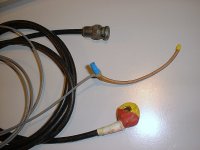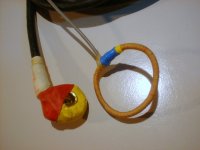virtually every meter measures current by measuring the voltage across a resistor. So depending on the amount of current you wish to measure and the sensitivity of the scope etc you can calculate the value of the resistor you need. ie 1ma through a 1kohm resistor will give you 1 volt. through a 100 ohm resistor 0.1 volt, with a 10ohm resistor .010 volt or 10 milli volt. So a current meter with a 10ohm resistor has a sensitivity of 10 millivolts per mili amp. A sound card cannot measure dc as they normally have a blocking capacitor on the input.
knowing what you want to measure would be helpful.
knowing what you want to measure would be helpful.
Allegro makes some interesting linear HALL devices that might be adapted. No such thing as a cheap clip on current probe that does audio bandwidth.
Easiest is probably a 10 Ohm power resistor in series with line.
Doc
Allegro MicroSystems - 0 to 50 A Integrated Conductor Sensor ICs
Easiest is probably a 10 Ohm power resistor in series with line.
Doc
Allegro MicroSystems - 0 to 50 A Integrated Conductor Sensor ICs
Last edited:
only good current probe for full Audio bandwidth - and a fair bit more so you can see HF things - that I know of and is affordable is the Tektronix P6042. This covers DC to 50MHz with a 50ohm output to match a 'scope or DMM; so should work with a soundcard input but with limited bandwidth.
These are now quite old but can be found for reasonable cost in working condition.
Mik
These are now quite old but can be found for reasonable cost in working condition.
Mik
Last edited:
Hello guy´s. I did a current probe with an old clamp meter, removing all electronics, only the coil and mechanical components. I placed a 1R 1W resistor between coil terminals and solder a coax wire from an broken oscilloscope probe. This is not so accurate, but for search phase differences in variable speed industrial equipment is very effective. I´m talking about tenths of amperes, in quasi sinusoidal waves. The scale factor in this case is of less importance than the quality of the wave to be viewed in a 20MHz scope. Perhaps you can emulate this best oriented for audio applications.
Good luck!!!
Good luck!!!
Hello guy´s. I did a current probe with an old clamp meter, removing all electronics, only the coil and mechanical components. I placed a 1R 1W resistor between coil terminals and solder a coax wire from an broken oscilloscope probe.....
Good idea! I had thought of trying the same but hadn't gotten to it yet. It would of course only work on AC. I repaired lots of the old TEK probes. They used custom HALL IC's mounted in a flux transformer head. The surface of the trap door lid had to be glass smoothe or they wouldn't work right.
Doc
"It would of course only work on AC. "
OK, yes, at the output of a variable speed controller always is there AC currents, except when DC injection for fast braking.
Good luck.
Hello tvrgeek,
If you want an easy to do and non intrusive solution that measure AC and DC current for a very reasonable cost, you can look the LEM current sensor like this one.
Unlike a shunt solution, your are not bothered by the common mode issue and you have also no additionnal loss.
The output signal are a current, that is it better if you use long coax wire to go on your scope input.
These type of sensors can measure high or low current level accurately. Bandwidth are not exeptionnal but probably sufficient for audio investigation (~200kHz).
You can easily get higher sensitivity with more turns on the current sensor(sensitivity are multiplied by the number of turns).
So, many LEM (or other brand) sale many type of these sensors withs differents nominal sensitivity and with voltage or output mode, you have the choice !
Regards.
FRex.
If you want an easy to do and non intrusive solution that measure AC and DC current for a very reasonable cost, you can look the LEM current sensor like this one.
Unlike a shunt solution, your are not bothered by the common mode issue and you have also no additionnal loss.
The output signal are a current, that is it better if you use long coax wire to go on your scope input.
These type of sensors can measure high or low current level accurately. Bandwidth are not exeptionnal but probably sufficient for audio investigation (~200kHz).
You can easily get higher sensitivity with more turns on the current sensor(sensitivity are multiplied by the number of turns).
So, many LEM (or other brand) sale many type of these sensors withs differents nominal sensitivity and with voltage or output mode, you have the choice !
Regards.
FRex.
One possibility is a Rogowski probe.
Here is an home-made example. Its slim form factor and small dimensions mean the LF response is limited, but with a suitable conditioning circuit, it is still capable of resolving a few mA down to 30Hz.
It was made for power supply tests, not audio.
The construction is of gimped wire wound on a silicone and PTFE core.
Here is an home-made example. Its slim form factor and small dimensions mean the LF response is limited, but with a suitable conditioning circuit, it is still capable of resolving a few mA down to 30Hz.
It was made for power supply tests, not audio.
The construction is of gimped wire wound on a silicone and PTFE core.
Attachments
How easy is it to make a Rogowski probe?
Does it need a special construction to give acceptable results into a scope input?
The wiki diag and others make it look quite simple and
File:RC PULSE.png - Wikipedia, the free encyclopedia
mentioned an ad8220 opamp
Does it need a special construction to give acceptable results into a scope input?
The wiki diag and others make it look quite simple and
File:RC PULSE.png - Wikipedia, the free encyclopedia
mentioned an ad8220 opamp
Found this.
AC Current Probe
A lot bigger torrid, a lot more turns, a lot smaller termination. So far real ones are in the $600 and up range used. Burp.
AC Current Probe
A lot bigger torrid, a lot more turns, a lot smaller termination. So far real ones are in the $600 and up range used. Burp.
The 50 Ohm outputs are a no-go as I don't have an old Tek mainframe with 50 Ohm amps.
Not exactly how that works. A probe that expects a 50 Ohm termination (load) will work just fine into a high impedance input, just put a 50 ohm resistor across it.
Doc
Back in my lab days, I guess ours were so integrated you could not do that easily.
You probably remember the little white tek 2W models of the 50 ohm feed through terminations.
BNC M-F FEED-THRU TERMINTR 50OHM - 4119-50
50 OHM FEED THROUGH TERMINATOR-MPJA, Inc. But out of stock.
Geeze, used to be a lot cheaper. Probably ought to go through my junk boxes and see just how many I have hanging around.
Doc
The ones we had were a matched set that were not BNC. THe probes and the amp were a plug in to the, darn 4900 mainframe? What was that 4 channel phosphor storage scope. Darn, long time.
Anyway, I have a ES-687 AC/DC amp clamp. It has a 4A range, so that gets it down to the milli-volts. Anyone ripped these apart to see if the signal could be tapped before it is rectified and sent to the voltmeter? Probably less than 2K bandwidth if I had to guess.
Anyway, I have a ES-687 AC/DC amp clamp. It has a 4A range, so that gets it down to the milli-volts. Anyone ripped these apart to see if the signal could be tapped before it is rectified and sent to the voltmeter? Probably less than 2K bandwidth if I had to guess.
- Status
- This old topic is closed. If you want to reopen this topic, contact a moderator using the "Report Post" button.
- Home
- Design & Build
- Equipment & Tools
- Current probe for scope

